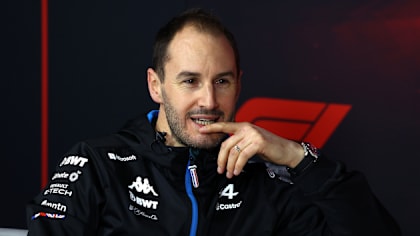Available only to F1 Access subscribers, Formula1.com's live Race Performance Ratings provide unprecedented real-time insight into the action as it unfolds on track during the Grand Prix. For the very first time, the inputs a driver makes can be tracked and viewed by fans, who can compare competitors head-to-head, and at any stage of the race. In the fifth and final feature explaining how the Ratings are calculated, we take a look at Throttle - and ask what it can reveal about how teams and drivers tackled the recent race in Canada...
What are Race Performance Ratings?
Five key parameters are measured: Aggression, Braking, Cornering, Steering and Throttle. Each category is determined by the raw telemetry from each driver, but given the sensitive nature of that data the Ratings are expressed as an indexed score, with each driver ranked on a scale of 1-10 based on how they compare to their competitors.
The individual scores for each of the five categories - which update every five seconds throughout the race - are averaged to give an overall Race Performance Rating, which can be tracked live during each race in 2015.
Throttle
The throttle score is calculated primarily from two parameters: throttle engagement and overall top speed. These two variables are multiplied together to give an individual score for each driver, meaning that every input from the driver - be it a small change of pressure on the accelerator, or easing off slightly before each corner - is tracked and reflected in their individual total. This score is then indexed against the scores for the entire field, to produce the values accessible in the Race Performance Rankings.
By nature of the maths, acceleration out of corners - the speed and magnitude with which drivers are able to open up the throttle - has a markedly greater influence on the total score than top speed.
Bottas eclipses the Ferraris
Over the four Grands Prix prior to Canada, Williams’ Valtteri Bottas had always scored lower than either Sebastian Vettel or Kimi Raikkonen in the throttle rankings. In Canada, where he claimed his first podium of 2015, the dynamic was reversed.

As the graph above shows, Bottas in fact posted the highest score of the entire field for the majority of the race. While top speed is a factor in this calculation, the high score is more reflective of the Finn’s ability to get on the power very early out of each corner - which unsurprisingly ties in with the fact this was one of Williams’ most competitive races so far this year.
Bottas’ main competition in this race, of course, was Raikkonen. The Ferrari driver also started the race with a very high score as he sought to keep pace with the Mercedes - and at this point he was also able to ease away from Bottas. The key moment comes on lap 28, when Raikkonen spun at the hairpin. The Finn’s throttle score plummets as a result, and he also cedes third to Bottas.
The dynamic between the pair does not change notably however - Raikkonen keeps the pressure on Bottas, meaning neither can afford to back off. But when Raikkonen pits for a second time on lap 41, Bottas is able to gradually ease off, leading to the slight fall we can see in his score over the remaining 20 laps.
It is worth noting that, in comparison to Raikkonen, Vettel’s score is initially far lower. This is probably reflective of traffic: for the first nine laps the German had to fight his way through from the rear of the grid, and his score suffers as a result of the compromises he has to make on corner exit. A pit stop on lap eight gives him free air however, and his score rapidly increases as a result. Though he meets with traffic again, by this point he is no longer in a pack of cars, and thus is able to fight his way back into clean air with little fuss on each occasion. The two subsequent drops he experiences, around lap 34 and 42, coincide with the two occasions he gets within one second of another car (Romain Grosjean and Nico Hulkenberg respectively) and cannot overtake immediately.
A tale of two McLarens

While the initial discrepancy between Raikkonen and Vettel is explained by traffic, there is a different dynamic in play when comparing the McLarens of Jenson Button and Fernando Alonso.
Button initially posts the lowest score of the field - like Vettel an indication of the compromises he has to make in traffic. On lap five that begins to change as he has clean air following a drive-through penalty, but by lap 14 he and Alonso begin to get messages about fuel saving, which generates two very different responses.
Given that saving a little fuel on every lap is theoretically the fastest option over a race distance, Button’s radio transmissions confirm that he begins to adopt more lift and coast measures, coinciding with him falling back to the lowest scorer in the throttle rankings. Alonso, meanwhile, is pushing hard to stay in touch with several big battles as the race progresses, and rejects requests to save fuel - leading to the now famous message: “Already I have big problems now, driving with this and looking like amateurs. So I’d like to race and then I will concentrate on fuel”.
His score stays consistently high as a result, but with the caveat that it will likely plummet at the end of the race. It does indeed begin falling around half distance, but such concerns ultimately prove academic as the Spaniard retires on lap 44. Button also exits 10 laps later, and as the lowest scorer his retirement causes all other scores to drop as a result.
Renault struggle to make an impact

Even with Button propping up the bottom of the throttle scores, it is not Honda that post the lowest average score for a power unit manufacturer. That distinction falls to Renault.
This is by no means typical of the 2015 season - in fact Toro Rosso’s Max Verstappen had been the highest scorer of the field in each of the last four Grands Prix, with team mate Carlos Sainz often second. In Montreal, however, the pair’s scores dropped markedly - as did those of Red Bull stable mates Daniel Ricciardo and Daniil Kvyat.
The cause appears to lie with how the Renault-powered teams set their cars up to deal with the high-speed nature of the Circuit Gilles Villeneuve. “We try to adapt with really low downforce, low wing settings,” Red Bull motorsport advisor Helmut Marko explained, “but there is a limit to what you can achieve with that.”
While top speed was boosted, such changes compromise overall downforce, making it harder to get on the power early out of corners. As noted earlier, it is acceleration far more than top speed that influences the overall score - which appears to explain why Renault-powered teams, specifically Toro Rosso, saw their scores suddenly drop.
Enhance the way you experience Formula 1 racing, and discover a level of detail you won't find anywhere else - complete with in-depth insights, exclusive content, up-to-the-minute race data, and more - with F1® Access. To find out more, click here.

)


